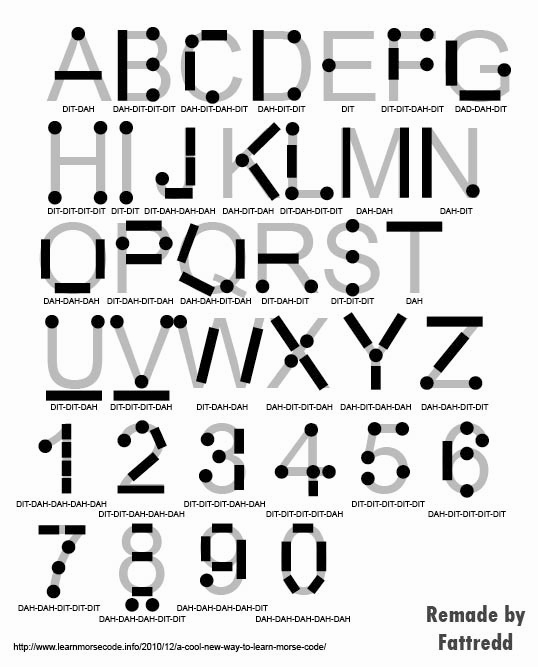Learning Morse Code is just like learning a new brand new language and as such needs a plan of attack and practice. Here are some ideas:
Morse Code Tip #1: Slow and Steady Wins the Race
Begin to learn Morse Code by starting out with the easiest and simplest letters in the alphabet.
Some of the easiest letters are:
- E (. or dit)
- T (- or dah)
- M (– 0r dah dah)
- I (.. or dit dit)
These Morse Code letters are the only letters in Morse Code that use one or two dits and dahs and do not combine the dits and dahs.
From there, the next easiest step is to move onto the simple dit and dah combinations, those using only 2 or 3 dits and dahs.
Here are the next Morse Code letters to learn:
- A (.- or dit dah)
- D (-.. or dah dit dit)
- G (–. or dah dah dit)
- (H) (…. or dit dit dit dit)
- K (-.- or dah dit dah)
- N (-. or dah dit)
- O (dah dah dah)
- R (.-. or dit dah dit)
- S (… or dit dit dit dit)
- U (..- or dit dit dah)
- W (.– or dit dah dah)
Finally, ending with the more difficult letters like “C”, “L”, “Q”, and “X”, that combine 4 dits and dahs in no particular “order”.
Here are the more difficult Morse Code letters:
- B (-… or dah dit dit dit)
- C (-.-. or dah dit dah dit)
- J (.— or dit dah dah dah)
- L (.-.. or dit dah dit dit)
- F (..-. or dit dit dah dit)
- Q (–.- or dah dah dit dah)
- P (.–. dit dah dah dit)
- V (…- or dit dit dit dah)
- X (-..- or dah dit dit dah)
- Y (-.– or dah dit dah dah)
- Z (–.. or dah dah dit dit)
Morse Code Tip #2: If at all possible, try to avoid visualization.
- Your ears hear the code
- Your mind says, “Hey, that’s Morse Code!”
- Your brain tries to bring up an IMAGE of the Morse Code letter or number you’ve heard
- Your brain tries to match the IMAGE to the SOUND
- Finally, you decide on a sound, or you miss the letter, and try to go on to the next letter
Morse Code Tip #3: Listen to Morse Code as often as you can.
Thanks to modern technology, you can find recordings of Morse Code just about anywhere – and you can find versions that are played back slower than what would be considered “normal” conversation.
Take advantage of these options to listen to More Code and use these recordings and videos as tools to test your learning progress.
This is especially important for learning the timing and spacing between letters and between words, as well as being able to instantly and effortlessly tell the difference between a dit and dah length of time.
Morse Code Tip #4: Use Your Own Voice!
Like most languages, Morse Code is both a written and auditory language. To prepare for listening to and translating dits and dahs, many people find it helpful to use their own voices to sound out letters and sentences as they practice.
Another way of incorporating the learners voice is to translate a short story, children’s book, or paragraph while recording. This is a great way of creating a simple test that can be “graded” without any outside assistance later.
Morse Code Tip #5: Have Fun!
As with learning anything, the more personal, entertaining, and a part of everyday life the new skill becomes, the quicker it is learned and the better it “sticks”. This can easily be applied to Morse Code. Emails, texting, grocery lists, notes to loved ones, and journaling are all great options for incorporating Morse Code into everyday life for a little bit of fun practicing as well as getting others around you interested in a new hobby as well!
Morse Code Alphabet Video – Learn Morse Code
Here’s a Morse Code video I created which gives the Alphabet in Morse Code.
httpv://www.youtube.com/watch?v=kDeVR6sWFZ4
I basically give the Morse Code alphabet one letter at a time – plus, there’s a secret message in the beginning of the video which will be fun to decode! Email me if you figure out what the secret message means.
Morse Code Alphabet
The Morse Code alphabet can be written on a computer. For instance, in the International Morse Code, the letter “A” in the alphabet is “.-”. This is a dot-dash, and you say it, “Dit-dah.”
Here is the rest of the Morse Code alphabet via a table.
Morse Code Alphabet
The International morse code characters are:
Morse Code Alphabet
A •-
N -•
0 —–
B -•••
O —
1 •—-
C -•-•
P •–•
2 ••—
D -••
Q –•-
3 •••–
E •
R •-•
4 ••••-
F ••-•
S •••
5 •••••
G –•
T –
6 -••••
H ••••
U ••-
7 –•••
I ••
V •••-
8 —••
J •—
W •–
9 —-•
K -•-
X -••-
• •-•-•-
L •-••
Y -•–
, –••–
M –
Z –••
? ••–••
